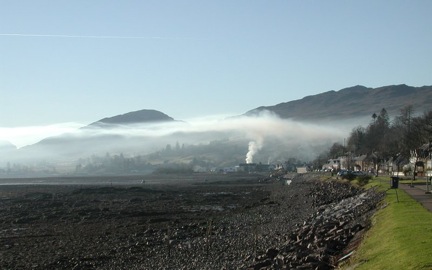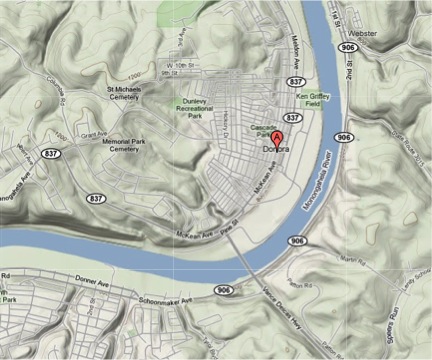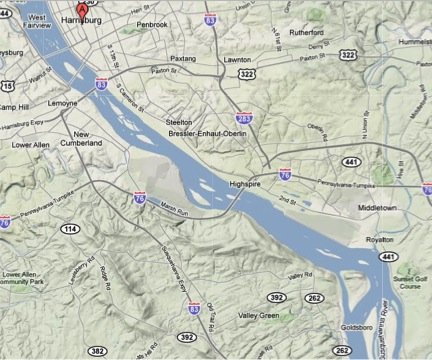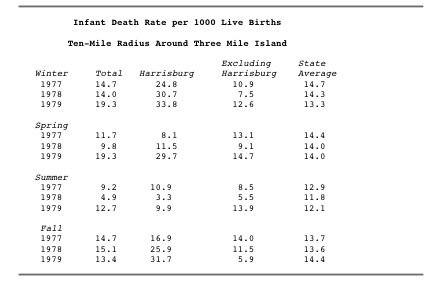• • •
"Mike and Jon, Jon and Mike—I've known them both for years, and, clearly, one of them is very funny. As for the other: truly one of the great hangers-on of our time."—Steve Bodow, head writer, The Daily Show
•
"Who can really judge what's funny? If humor is a subjective medium, then can there be something that is really and truly hilarious? Me. This book."—Daniel Handler, author, Adverbs, and personal representative of Lemony Snicket
•
"The good news: I thought Our Kampf was consistently hilarious. The bad news: I’m the guy who wrote Monkeybone."—Sam Hamm, screenwriter, Batman, Batman Returns, and Homecoming
March 24, 2011
A Geographical Note About the Infant Death Rate at TMI
By: Aaron Datesman
You may be aware of the London Big Smoke, which killed about 12,000 people in 1952. It was caused by a temperature inversion: a layer of cold, stagnant air trapped under a lid of warm air. This phenomenon can temporarily halt convective transport in the atmosphere locally: that is, it prevents the atmosphere from mixing (and prevents dispersion of pollutants). The mechanics are similar to the considerations Thomas Jefferson made for siting Monticello, which I mentioned in comments here. Wikipedia has a nice picture of the effects of a temperature inversion over a factory in Scotland, below. Note how the factory effluent fails to cross the boundary between the cold, dense layer near the ground and the warmer cap above.

Generally the atmosphere is warmer closer to the earth, since air is transparent to sunlight and warmed from below. The temperature of the air is a balancing act between the energy incident from the sun and the thermal energy radiated by the earth. Although temperature inversions don’t ordinarily kill thousands of people, they are common. They are most common a) at night, and b) in winter, when the sun provides a lower density of incident energy.
An event similar to the Big Smoke occurred in Donora, PA, on October 27, 1948. The Donora Smog killed 20 people and 800 animals, and was one of the precipitating events leading to passage of the Clean Air Act in 1970. Donora is in the Monongahela River Valley south of Pittsburgh. I worked in nearby Charleroi, PA for a while in 2006. This is a topographic map of the Mon Valley around Donora. You will certainly notice the hills on both sides of the river, with Donora tucked into a flat spot on the west bank. That a strong temperature inversion would occur in this terrain is hardly surprising. In fact, I suspect that at least mild inversions are probably common in the Mon Valley at night in fall and winter, since cold, dense air will slide off of the hills and down into the trough of the river, displacing warm air.

This is a topographic map of the area around Three Mile Island and Harrisburg, PA. Three Mile Island is in the lower right, on the island labeled “Susquehanna River”. It is somewhat more hilly in the Mon Valley than around Harrisburg, but the difference is accentuated because the scales on the maps are different. It’s pretty hilly in the Susquehanna Valley around Harrisburg, too.

Therefore, I have a reasonable suspicion that temperature inversions frequently occur on the river on cold fall and winter days (and at night) in the area around Harrisburg. (I think Thomas Jefferson, who knew a few things, would back me up on this.) This would prevent emissions (including permitted emissions of radioactive gases – yes, there are such things, and quite a lot of them actually) from the reactors at Three Mile Island from dispersing to the wider atmosphere, as shown with the smoke in the picture from Scotland above.
Instead, fallout (I fail to see the difference between fallout and “emissions”) would most likely settle in the immediate vicinity of TMI. Depending on the exact characteristics of the warm cap layer in the inversion, the flat plain on which Harrisburg sits is a very likely destination.
This is the infant death rate data from Wasserman and Solomon quoted in an earlier post. The interesting question is, do the high infant mortality rates in Harrisburg in fall and winter really have a sociological explanation? I find it disturbing that there’s not a corresponding trend in the state-level data. (The rate does dip a bit in the summer.)

A plausible hypothesis, it seems to me, is that this data covers information from two discrete sets of fallout events. The first is the accident at TMI-2, in spring 1979. The second set of fallout events correspond to routine emissions from TMI-1, trapped along the river by atmospheric inversion layers and deposited in Harrisburg as fallout. This hypothesis explains the puzzling seasonal variation. TMI-1, which appears to have had an excellent official safety record, opened in 1974.
This is from the prologue to the Marie Holowka interview in the TMIA archives:
The Holowka’s have had many animal problems on their farm since the time TMI began operation in 1974.
The hypothesis is testable, of course: it could easily be disproved using data like that in the chart from the years before 1974. I do not have that data, and so I don’t even intend to offer the hypothesis (although I know that I stated it). Instead, I wrote this post to show how complicated the analysis of emissions and fallout really ought to be. Therefore, when I read statements like that from Dr. Kemper that fission byproducts are light and disperse harmlessly into the atmosphere, I engage in the short daydream that there is a licensing board for physicists, and that I can slap the speaker, and take away his right to integrate.
We would never allow this technology to exist if we really understood all of the complications which necessarily follow, but are never considered.
— Aaron Datesman
I don't know if this is salient or not, but it may be worth mentioning. In the summer around Harrisburg it gets to be in the 90's on hot days, but the days aren't so bad. It's at night that it seems the humidity settles down in the Susquehanna River valley, and it becomes unbearable without air conditioning. If you get a glass of water, the condensation from the air immediately forms a sizable puddle around the base of the glass. Water vapor is not very heavy though, so I wonder how the polarity of water effects this. But at any rate it wouldn't surprise me if fallout just sits down in there... By the way do you think that the data on leukemia rates near nuclear plants are credible? -They seem too astonishing to be true. See http://www.globalresearch.ca/index.php?context=va&aid=13825
Posted by: rien at March 24, 2011 06:01 PMOK, my dad's from Donora, so he's getting a link.
Posted by: godoggo at March 24, 2011 06:26 PMIt looks like there *should* be pretty detailed historic data from the Capital City Airport's weather station.
http://www4.ncdc.noaa.gov/cgi-win/wwcgi.dll?wwDI~StnSrch~StnID~20016690
Based on the inventory, dataset 3280 looks like it has hour-by hour reports of the runway conditions during the period (probably the METAR information). But the download link isn't active. The other stations in the area don't appear to even have data indexed by the system.
Anyhow, you might want to contact them and see if they can provide the information, it clearly exists.
That's another very fine post. I still look forward to reading about ozone, though I guess we know where that is going.
About that ending--"We would never allow this technology to exist if we really understood all of the complications which necessarily follow, but are never considered." That's provocative, because I think much the same thing can be said about many things, which is a commonly held view sometimes expressed in the statement "don't ask what's in the sausage."
There are two problems I see with the suggestion that there should be no nukes, the first relating to control/power over the technology, the second the energy issue.
The first point used to be paramount, especially until the Cold War ended, and it's still very important to our nationalistic military types who don't like international institutions to have control over such things (unless they control the international institutions). That's a problem--the MICFiC wants its nukes, and it needs a nuclear industry for them. Since the MICFiC is running the show and gets what it wants, democracy be damned, "we" will be forced to "allow" whatever they want. It ain't really up to us--we just get to pretend.
But anyway, while we're pretending the second point is now clearly paramont--what energy sources do we have that aren't going to kill lots of people. That's what Lovelock and Monbiot would ask--if we don't have nuclear energy, we'll have to make up for it with hydrocarbons, and that will finish off the whole planet. How is that better?
What's the answer to that ecological point? Hundreds of thousands or even a few million gruesome deaths--if that's the realistic worse case scenario from nuclear energy--aren't as bad as the realistic worse case scenario for unrestrained man-made climate change if hydrocarbon emissions don't drop. THAT worse case scenario is a real mind bender, the likes of which haven't been since the Pleistocene or the Jurassic or whatever.
Are wind and solar going to meet all our needs? Are we going to find some dilithium crystals pretty soon? We're looking over the side of a cliff here, and the rocks below are jagged.
Posted by: N E at March 25, 2011 09:05 AMfrom The Oil Drum
href="http://www.theoildrum.com/node/7706">Fukushima Dai-ichi status and slow burning issues
Posted by: mistah charley, ph.d. at March 25, 2011 12:53 PMkgb999 - Thanks for that insight, it's a good one. Smart of you to observe that the Hbg airport is right there.
NE - One of Wasserman and Solomon's points, earlier in their book, is that we wouldn't have a commercial nuclear industry if not for the military desire for nuclear weapons. I agree.
As to the second point, actually we could around get rid of all of our nukes just by adopting new coal technology - burn the same amount of coal, but with new plants. I will write a post to this effect later. The Holowka story, too. I'm not trying to keep anybody on hooks, it's just that I have an arc planned and want to end with that piece.
Posted by: Aaron Datesman at March 25, 2011 01:35 PMThanks for these posts Aaron, they're good, and I don't like to skip ahead to read the ending of books anyway, so I can wait.
Posted by: N E at March 25, 2011 02:17 PMThere wouldn't be an internet if if weren't for the desire to mass launch nuclear weapons.
Posted by: Mike Meyer at March 25, 2011 03:14 PMThere wouldn't be an internet if if weren't for the desire to mass launch nuclear weapons.
Posted by: Mike Meyer at March 25, 2011 03:14 PMThere wouldn't be an internet if if weren't for the desire to mass launch nuclear weapons.
Posted by: Mike Meyer at March 25, 2011 03:14 PMMike Meyer - definitely your most inciteful post ever.....
Posted by: Aaron Datesman at March 25, 2011 03:27 PMMaybe I meant, "insightful". Huh.
Posted by: Aaron Datesman at March 25, 2011 04:10 PMIt does tend to remind me of the beginning of 2001: A Space Odyssey. Technology -- from a tapir's jawbone to nuclear power -- is a two-edged sword, and all tools have multiple uses. The question is, will we grow up in time to put them to best use? I tend to doubt it, but I suppose one has to continue to hope.
Posted by: NomadUK at March 25, 2011 07:37 PMCynicism of the Day
"No lesson seems to be so deeply inculcated by the experience of life as that you never should trust experts."
- Lord Salisbury, letter to Lord Lytton, 1877
"We do not really feel grateful toward those who make our dreams come true; they ruin our dreams."
- Eric Hoffer
"I suppose it can be truthfully said that hope is the only universal liar who never loses his reputation for veracity."
- Robert G. Ingersoll
Great piece to come across on the anniversary of 3 Mile Island.
Posted by: Melissa at March 28, 2011 02:06 PMOne other thought. There were a LOT of intentional releases from the Hanford (Washington) complex during it's operation. Some of them were literally human experiments. Over the years the victims have gotten pretty good documentation of the radiation releases and the fallout patterns have been mapped pretty well also.
I don't have time to go back through all the research, but my recollection is those studies definitively show that fallout tends to concentrate based on land features (etc.) and not just diffuse evenly. There might be some applicable information regarding how this stuff is observed to dissipate within those reports.
Posted by: kgb999 at March 29, 2011 01:39 PM


